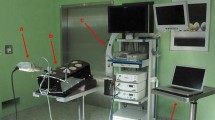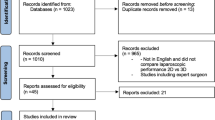Abstract
Background
We aimed to compare the performance of novices with three-dimensional (3D) versus two-dimensional (2D) laparoscopy using Fundamentals of Laparoscopic Surgery (FLS) tasks.
Methods
Fifty-six novices with no uncorrected visual problems were randomly allocated to 2D and 3D groups. All candidates practiced FLS tasks on a box trainer until they achieved proficiency. Their performance was assessed by considering completion time, number of repetitions, and number of errors following the validated FLS proficiency criteria.
Results
Twenty-five participants in each group completed the training curriculum. The median performance time (in minutes) for the 3D group was 216, which was less than that of the 2D group of 247 min (P = 0.266). The median numbers of repetitions and errors were lower for the 3D group versus the 2D group: 108 versus 121 (P = 0.008) and 27 versus 105 (P < 0.001), respectively.
Conclusion
Stereoscopic vision improved accuracy in laparoscopic skills for novices, which was manifested in reduced numbers of repetitions and errors. However, it does not affect the global performance time across all tasks.


Similar content being viewed by others
References
Wagner OJ, Hagen M, Kurmann A, Horgan S, Candinas D, Vorburger SA (2012) Three-dimensional vision enhances task performance independently of the surgical method. Surg Endosc 26(10):2961–2968
Heemskerk J, Zandbergen R, Maessen JG, Greve JW, Bouvy ND (2006) Advantages of advanced laparoscopic systems. Surg Endosc 20(5):730–733
Ohuchida K, Kenmotsu H, Yamamoto A, Sawada K, Hayami T, Morooka K et al (2009) The effect of CyberDome, a novel 3-dimensional dome-shaped display system, on laparoscopic procedures. Int J Comput Assist Radiol Surg 4(2):125–132
LaGrange CA, Clark CJ, Gerber EW, Strup SE (2008) Evaluation of three laparoscopic modalities: robotics versus three-dimensional vision laparoscopy versus standard laparoscopy. J Endourol 22(3):511–516
Bhayani SB, Andriole GL (2005) Three-dimensional (3D) vision: does it improve laparoscopic skills? an assessment of a 3D head-mounted visualization system. Rev Urol 7(4):211–214
Smith R, Day A, Rockall T, Ballard K, Bailey M, Jourdan I (2012) Advanced stereoscopic projection technology significantly improves novice performance of minimally invasive surgical skills. Surg Endosc 26(6):1522–1527
Gallagher AG, Ritter EM, Lederman AB, McClusky DA 3rd, Smith CD (2005) Video-assisted surgery represents more than a loss of three-dimensional vision. Am J Surg 189(1):76–80
Kobayashi E, Ando T, Yamashita H, Sakuma I, Fukuyo T, Ando K et al (2009) A high-resolution, three-dimensional thin endoscope for fetal surgery. Surg Endosc 23(11):2450–2453
Roach VA, Brandt MG, Moore CC, Wilson TD (2012) Is three-dimensional videography the cutting edge of surgical skill acquisition? Anat Sci Educ 5(3):138–145
Held RT, Hui TT (2011) A guide to stereoscopic 3D displays in medicine. Acad Radiol 18(8):1035–1048
Kong SH, Oh BM, Yoon H, Ahn H, Lee HJ, Chung S et al (2010) Comparison of two- and three-dimensional camera systems in laparoscopic performance: a novel 3D system with one camera. Surg Endosc 24(5):1132–1143
Radermacher K, Fischer S, Rau G (1998) 3D-Visualisation in surgery. Helmholtz-Institut for Biomedical Engineering, Aachen University of Technology, Aachen, Germany, p 6
Storz P, Buess GF, Kunert W, Kirschniak A (2012) 3D HD versus 2D HD: surgical task efficiency in standardised phantom tasks. Surg Endosc 26(5):1454–1460
Patel HR, Ribal MJ, Arya M, Nauth-Misir R, Joseph JV (2007) Is it worth revisiting laparoscopic three-dimensional visualization? a validated assessment. Urology 70(1):47–49
Hanna GB, Shimi SM, Cuschieri A (1998) Randomised study of influence of two-dimensional versus three-dimensional imaging on performance of laparoscopic cholecystectomy. Lancet 351(9098):248–251
Bilgen K, Üstün M, Karakahya M, Isik S, Sengül S, Çetinkünar S et al (2013) Comparison of 3D imaging and 2D imaging for performance time of laparoscopic cholecystectomy. Surg Laparosc Endosc Percutan Tech 23(2):180–183
Mistry M, Roach VA, Wilson TD (2013) Application of stereoscopic visualization on surgical skill acquisition in novices. J Surg Educ 70(5):563–570
Tanagho YS, Andriole GL, Paradis AG, Madison KM, Sandhu GS, Varela JE, Benway BM (2012) 2D versus 3D visualization: impact on laparoscopic proficiency using the fundamentals of laparoscopic surgery skill set. J Laparoendosc Adv Surg Tech 22(9):865–870
Derossis AM, Fried GM, Abrahamowicz M, Sigman HH, Barkun JS, Meakins JL (1998) Development of a model for training and evaluation of laparoscopic skills. Am J Surg 175(6):482–487
Society of American Gastrointestinal and Endoscopic Surgeons (SAGES) Fundamentals of Laparoscopic Surgery (FLS) program (2011) http://www.flsprogram.org
Scott DJ, Ritter EM, Tesfay ST, Pimentel EA, Nagji A, Fried GM (2008) Certification pass rate of 100 % for fundamentals of laparoscopic surgery skills after proficiency-based training. Surg Endosc 22(8):1887–1893
Honeck P, Wendt-Nordahl G, Rassweiler J, Knoll T (2012) 3D-laparoscopic imaging improves surgical performance on standardized ex-vivo laparoscopic tasks. J Endourol 26(8):1085–1088
Sinha R, Sundaram M, Raje S, Rao G, Sinha M, Sinha R (2013) 3D laparoscopy: technique and initial experience in 451 cases. Gynecol Surg 10(2):123–128
Conflict of interest
None.
Author information
Authors and Affiliations
Corresponding author
Rights and permissions
About this article
Cite this article
Alaraimi, B., El Bakbak, W., Sarker, S. et al. A Randomized Prospective Study Comparing Acquisition of Laparoscopic Skills in Three-Dimensional (3D) vs. Two-Dimensional (2D) Laparoscopy. World J Surg 38, 2746–2752 (2014). https://doi.org/10.1007/s00268-014-2674-0
Published:
Issue Date:
DOI: https://doi.org/10.1007/s00268-014-2674-0




